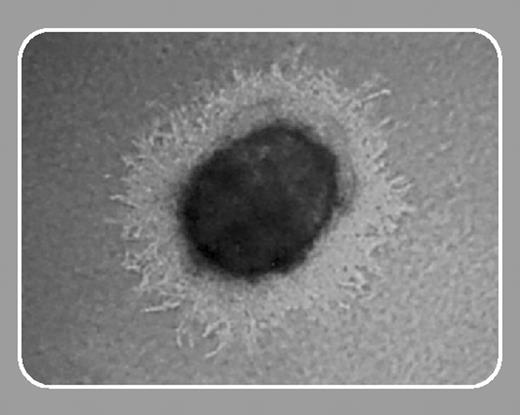Homeobox genes are a large family of transcriptional regulators that confer positional identity along the anterior-posterior body axis. Several homeobox genes play roles in blood cell proliferation and in leukemogenesis. Hex is a homeobox gene that has previously been shown to be an early marker of anterior-posterior asymmetry in the vertebrate embryo.1 It was also found to be transiently expressed in yolk sac blood islands.FIG1
The intimate temporal and spatial association of the vertebrate embryo's first blood cells with endothelial cells in blood islands of the yolk sac has long suggested that these 2 tissues can arise from a common hemangioblast precursor. This concept has been supported by the coexpression of many genes in blood cells and endothelium and by the functional role of genes such as SCL, LMO-2, and flk-1 both in vascular and hematopoietic development. While direct evidence for a hemangioblast cell in the embryo is still lacking, a growing body of work with cultures of murine embryonic stem cells has defined a precursor, termed blast colony-forming cell (blast-CFC), that has both hematopoietic and endothelial cell potential.2 The in vitro culture of embryonic stem cells as embryoid bodies has become a powerful model system for the investigation of early embryonic events, particularly the transition from epiblast cells to mesodermal fates. Several genes, including flk-1, SCL, and Runx-1 are important for blast-CFC development in embryoid bodies but little is known about other genes that regulate their subsequent differentiation into hematopoietic and vascular lineages.3
In this issue, Guo and colleagues (page 2428) report that Hex plays a functional role in the initial development of the hematopoietic and vascular systems. Investigating embryoid bodies derived from murine embryonic stem cells lacking Hex expression, the authors show that there is a significant drop in definitive hematopoietic precursors as well as defects in endothelial cell outgrowth. Interestingly, there was no reduction in primitive erythroid progenitors, indicating that Hex joins the ranks of transcriptional regulators, including Runx-1 and c-myb, that differentially regulate primitive versus definitive erythropoiesis.4 Unlike Runx-1,5 deficiency of Hex does not reduce blast-CFC numbers, indicating that Hex does not function at the level of the hemangioblast. These results point to a role for Hex in the differentiation of definitive hematopoietic cells and of endothelial cells and provide further indirect evidence that both of these lineages can arise from a common hemangioblast precursor.
Finally, the authors determine that Hexdeficient embryonic stem cells do not fully contribute to the lymphoid and myeloid cell compartments in adult chimeric mice. Are the roles of Hex in blood and endothelium related to a common embryonic precursor? Are the functions of Hex in embryonic and adult hematopoiesis similar? The answers to these and other vexing questions await future studies of Hex.


This feature is available to Subscribers Only
Sign In or Create an Account Close Modal